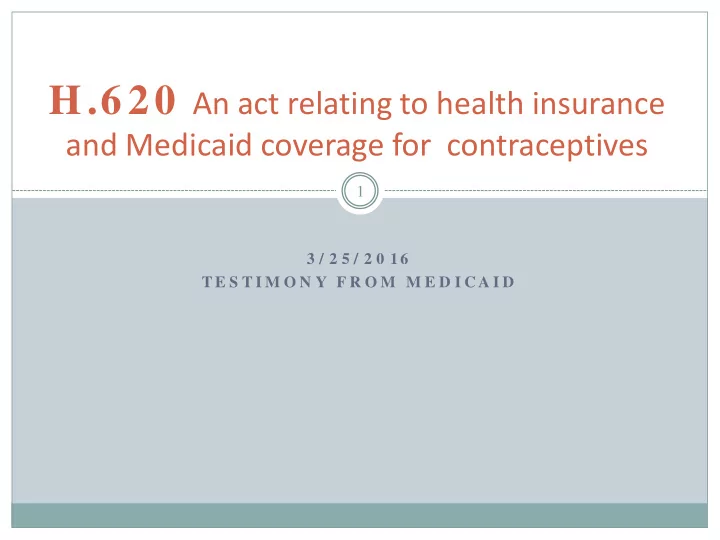

H.620 An act relating to health insurance and Medicaid coverage for contraceptives 1 3 / 2 5 / 2 0 16 T E S T I M O N Y F R O M M E D I C A I D
LARC Distribution by Service Location 2 The location of the LARC insertion can impact the cost to Vermont Medicaid. Physician’s Title X FQHC & RHC Hospital Office (Planned Parenthood) 44.9% 31.0% 6.2% 17.8% FQHCs and RHC are cost based clinics. Hospitals receive a $200 add-on for LARC insertions performed after delivery in addition to the DRG payment. This means that an increase to LARC payment will not impact either of these provider groups. Factors that Impact Reimbursement Rate for LARCs: 1. Provider Type 2. 340B Drug Discount Program Participation 3. Drug Rebates 4. Individual Medicaid/Provider contracts
LARC Reimbursement: Rate for Product vs. Rate for Insertion 3 Medicaid rates for LARC insertion are based on RBRVS methodology. It is not preferable to pull a single service from the RBRVS fee schedule: • It requires a SPA and would require justification and supporting data on the need for deviation from the methods for rate setting. For example, quantifiable demonstration of an access to care issue. • It requires procedures that deviate from standard operating procedures and are at high risk for errors in implementation or updates. • It sets precedent for resolution of rate disputes to result in arbitrary rates not set based on recent cost and utilization data. Medicaid has much more flexibility around rates for the actual LARC products.
LARC Reimbursement: Fiscal Impact on Increased LARC Product Rate 4 Estimated Net Fiscal Impact of 20% LARC Rate Increase $341,051 (20% LARC rate increase) - $306,187 (savings from additional 5% reduction in unintended pregnancies) $34,864 (gross/annualized) Proposed 20% increase to Medicaid Fee Schedule for reimbursement of LARC products. Percent increase providers see on paid claim will vary by provider type, depending on: Drug rebate participation • 340b participation • Setting (FQHC, hospital, outpatient) •
LARC Reimbursement 5 Fiscal Estimate for Outpatient LARC $341,051 gross/annualized Proposed rate increase for LARC product: 20% increase to Medicaid Fee Schedule Estimated utilization increase: 10% -Increased utilization is presumed as a result of increased promotion and awareness of LARC. Estimated total expenditure on Outpatient LARC, with 20% rate and 10% utilization increase: No Change in Utilization + 10% Utilization Annual Additional $ Additional Annual LARC Needed $ Needed LARC Spend (Gross) (Gross) Spend (Gross) (Gross) Current Annual Gross $0 Spend on LARC $1,065,783 $1,172,361 $106,578 20% Rate Increase $1,278,940 $213,157 $1,406,834 $341,051
Savings 6 Total Savings from 2 LARC initiatives: $2,681,187 gross/SFY18 $2,681,187 in Medicaid savings assumes a 30% reduction in unintended pregnancies the promotion of LARC in both inpatient and outpatient settings. $2,681,187 in cost savings includes: 1. Savings already booked in BAA* ($2,375,000 gross) for increasing post-partum inpatient DRG with an add payment to promote and capture post-partum contraceptive intervention. a. This savings assumed a 25% reduction in unintended pregnancies 2. Savings associated with H.620’s additional promotion of LARC in outpatient settings through a rate increase. a. Assumes an additional 5% reduction in unintended pregnancies (+$306,187 gross). * It is anticipated that LARC promotion in the outpatient setting will effect savings achieved through the inpatient setting, but DVHA estimated a combined savings of $2,681,187 between the promotion of LARC in both settings.
Recommend
More recommend